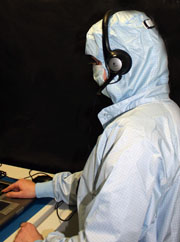The main focus of special clothing or personal protection equipment worn at work is usually on physical protection for people or products, but until now there has been no investigation into the influence of clothing on employees' mental performance and so on the outcome of their work.
Now researchers at the Hohenstein Institute in Bönnigheim, Germany, in co-operation with a pilot client, DASTEX Reinraumzubehör in Muggensturm, have studied this important question as part of a commissioned research project.
They tested the ability of volunteers to concentrate for long periods in cleanroom conditions. First of all, the subjects had to perform a challenging task requiring a high level of concentration in a specially developed "Stressbox". The volunteers were wearing different qualities of cleanroom clothing.
Following the stress phase, the mental performance of the volunteers was tested using a new software test system established at the Hohenstein Institute, which includes the requirements of international standards for workplace psychology. This tested both undivided attention and the ability of the volunteers to multitask.
The results of the Hohenstein survey confirm that, in the same environmental conditions, the volunteers wearing high-quality reusable clothing generally performed better than those wearing less breathable disposable clothing. This could be seen both in the speed of their reactions and in their error rate.

Volunteers wearing high-quality reusable clothing generally performed better
Picture: Hohenstein Institute
“These results are quite unambiguous, and also fascinating,” says Professor Dirk Höfer, Head of the Institute for Hygiene and Biotechnology at the Hohenstein Institute. “We have been working for a long time not only on product optimisation but also on occupational health issues and the effect of textiles on people, in this case of complete clothing systems on work performance.”
As well as typical types of work in cleanroom conditions, other examples of jobs requiring enormous amounts of concentration at work include operating for hours using fine mechanical skills, accurately mixing chemotherapy drugs in sterile conditions or air traffic control. Here the focus is not only on a quick reaction speed but also, and mainly, on keeping the error rate as low as possible. Now researchers can measure this error rate, in relation to the working situation and the clothes worn.
In future, the new test system will help people to select or adapt workplace-specific clothing to suit the required mental performance and work outcomes, meaning that manufacturers of clothing for the health care, armed forces or civilian protection forces (police, fire brigades) could also benefit from the new procedure.




